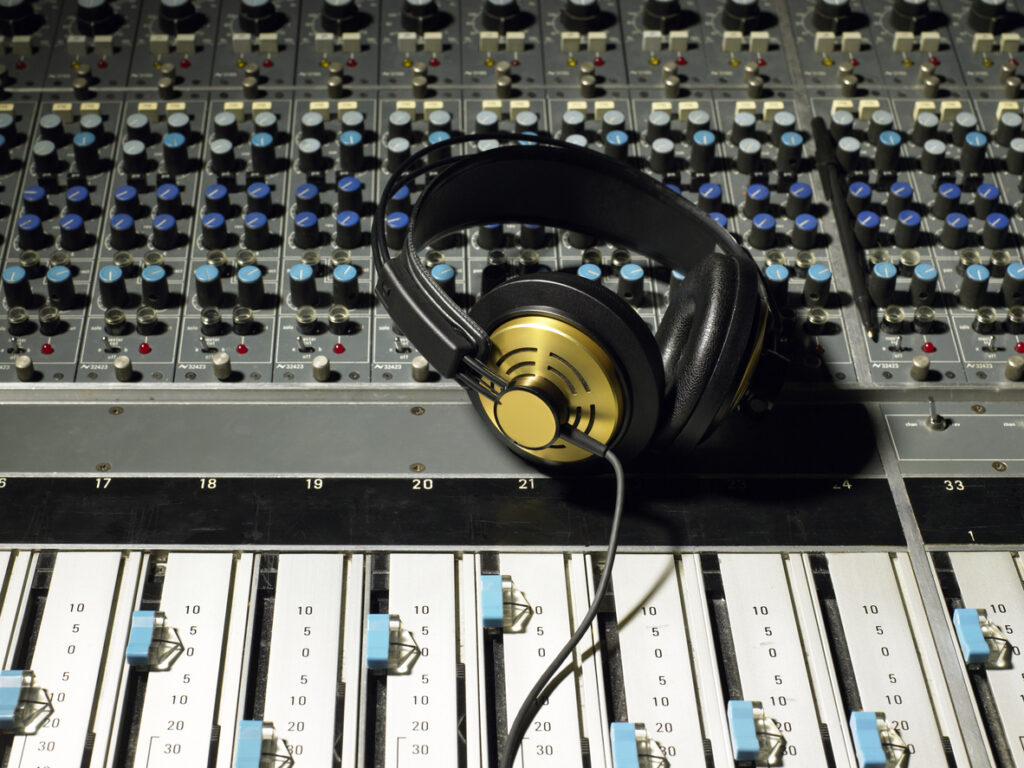Studio headphones are specialized headphones designed for professional audio applications. They prioritize accurate audio reproduction, enabling sound engineers, musicians, and audio enthusiasts to listen to music as it was intended by the creators. Unlike regular consumer headphones, which might enhance certain frequencies for a more ‘pleasing’ listening experience, studio headphones strive to provide a flat frequency response, which means they don’t artificially boost or cut any frequencies. This objective sound reproduction is essential in professional settings for mixing, mastering, and recording audio.
Current Trends in the Studio Headphones Market
Studio headphones, an integral element for professional audio applications, have seen a remarkable surge in popularity in Australia. The market for studio headphones has been on the rise, keeping in tune with global trends. As the country is home to a burgeoning community of musicians, sound engineers, and audio aficionados, the demand for high-quality studio headphones has seen significant growth. This surge is also supported by the rise in home studios, driven by advancements in digital audio technology and a desire for personal creative spaces among the Australia. Market analysis suggests that headphones boasting features like noise-cancellation, wireless technology, and long battery life are particularly sought after among Australian consumers. Moreover, the growing popularity of online streaming platforms, podcasts, and webinars, which require clear and balanced sound reproduction, further propels market demand. All the consumers show a willingness to invest in premium studio headphones that deliver superior audio quality, marking a promising trend for manufacturers and sellers in this niche.
Uses for Studio Headphones
There is a broad spectrum of applications where these specialized headphones are in high demand.
- Recording Studios: Studio headphones are essential tools in recording studios, where they are used by sound engineers and musicians alike. They ensure that the audio being recorded is of the highest quality, and that any imperfections can be detected and rectified early in the process.
- Home Studios: As digital technology advances, more and more people are setting up home studios. Studio headphones are central to these spaces, allowing individuals to create, mix, and master music independently.
- Podcasting: With the rise of podcasts, the demand for studio headphones has increased significantly. Podcasters rely on them to deliver clear and balanced sound for their recordings.
- Online Streaming: As streaming platforms for music and video have gained popularity, so has the need for superior audio quality. Studio headphones provide listeners with an enhanced experience.
- Virtual Meetings and Webinars: In the corporate world, clear communication is vital. Studio headphones are often used in virtual meetings and webinars to ensure that all participants can be heard clearly and that the audio is of high quality.
- Audiophiles: For audio enthusiasts or ‘audiophiles’, studio headphones are a prized possession. They appreciate the superior audio quality that these headphones deliver, and often use them for critical listening of music and audio.
- Noise-Cancellation Technology: Studio headphones often come equipped with noise-cancellation technology, making them ideal for use in noisy environments. This feature allows for a more focused and immersive listening experience.
- Wireless Technology: With the rise of wireless technology, many studio headphones now offer a wireless option, providing greater freedom of movement and convenience.
- Gaming: Studio headphones are also popular among gamers, who value the enhanced sound quality for an immersive gaming experience.
- Traveling: For frequent travelers, studio headphones prove useful in providing a high-quality audio experience on long flights or train rides.
Types of Studio Headphones
Studio headphones come in different types, each with its unique features and application. The three main types are closed-back, open-back, and semi-open headphones. Closed-back headphones are designed to seal around the ear, providing isolation from external noise. They also prevent sound leakage, making them ideal for recording and tracking purposes. Open-back headphones have openings in their ear cups which allow some airflow, resulting in a more natural sound with less bass emphasis. This type is preferred by audiophiles and those looking for a more ‘neutral’ sound

1. Closed-Back Headphones
Closed-back headphones have sealed ear cups that offer excellent sound isolation by preventing outside noise from entering the ear cups and vice versa. They also help to contain the sound within the headphones, making them ideal for recording or mixing audio in a studio environment. They are commonly used in production studios and home studios.
2. Open-Back Headphones
Open-back headphones have perforated ear cups that allow air to pass through, providing a more natural and open sound experience. They do not offer as much isolation as closed-back headphones, making them unsuitable for recording or mixing in a noisy environment. However, they are highly sought after by audiophiles for their ability to deliver a more natural and spacious sound.
3. Semi-Open Headphones
Semi-open headphones combine the features of both closed-back and open-back headphones. They have partially sealed ear cups, providing some noise isolation while also allowing for some sound leakage. These headphones offer a middle ground between the other two types and are often used in professional recording studios.
4. On-Ear Headphones
On-ear headphones, also known as supra-aural headphones, sit directly on your ears. They’re a hybrid between in-ear and over-ear headphones, providing a balance of portability and sound quality. They are often lightweight, making them a good choice for mobile or temporary studio setups. While they don’t provide as much isolation as closed-back headphones, they are known for their comfort and decent sound quality.
5. Over-Ear Headphones
Over-ear headphones, also known as circumaural headphones, have large ear cups that encase the entire ear. They are known for their superior sound quality and excel in keeping music inside and noise outside. These headphones are designed for audiophiles, producers, and sound engineers who demand the most detailed sounds. They usually have thick, padded ear cups which make them comfortable to use for extended periods, although they may be less portable than other types due to their size.
6. In-Ear Monitors (IEMs)
Custom In-ear monitors (CIEMs) are a type of earphone used by audio engineers and musicians to accurately monitor a mix. They are custom-fitted to an individual’s ear and provide excellent noise isolation. While IEMs are often used for live performances, many studios are also using them for recording and mixing. Their compact size makes them highly portable, but they may not provide the full soundstage that over-ear or open-back headphones do.
Each type of studio headphone offers its unique benefits, and the choice largely depends on the user’s individual needs, preferences, working environment, and budget.
Features to Consider When Choosing Studio Headphones
When shopping for studio headphones, there are several features to consider ensuring you get the right pair for your needs. These include:
- Frequency Response: This refers to the range of frequencies that a headphone can reproduce. For accurate sound reproduction, it’s essential to choose headphones with a wide frequency response.
- Impedance: Impedance is a measure of the electrical resistance that affects how much power is required to drive a headphone. Generally, lower impedance headphones are easier to drive and are better suited for use with portable devices.
- Sensitivity: Sensitivity refers to how loud a headphone can go at a given level of input. Headphones with higher sensitivity require less power to produce the same volume as those with low sensitivity.
- Durability: Studio headphones are an investment and should be durable enough to withstand daily use. Factors such as build quality, materials used, and manufacturer’s warranty play a role in determining the durability of a headphone.
- Comfort: Comfort is crucial when it comes to studio headphones, especially if you will be wearing them for extended periods. Look for headphones with cushioned ear cups and an adjustable headband for a comfortable fit.
- Portability: If you are a mobile producer or frequently travel with your headphones, portability is an important factor to consider. Lightweight and foldable headphones are more convenient to carry around.
- Noise Isolation/Cancelation: If you will be working in a noisy environment, it’s crucial to choose headphones with good noise isolation or active noise-canceling technology. This will help you focus on your work and eliminate distractions.
- Price: Studio headphones come in a wide range of prices, and it’s important to determine your budget before making a purchase. Keep in mind that higher-priced headphones may not always be the best option for your specific needs.
Choosing the right type of studio headphones and considering these features will ensure that you get the most suitable pair for your unique requirements. So whether you’re a music producer, sound engineer, or audiophile, make sure to do your research and invest in high-quality headphones for the best listening experience!
Conclusion
In conclusion, navigating the vast world of earphones can initially seem overwhelming due to the array of types and features available. However, armed with the knowledge of different headphone types and understanding of key features like frequency response, impedance, sensitivity, durability, comfort, portability, noise isolation/cancellation, and price, you can confidently make an informed choice. Remember, the choice of studio headphones significantly influences your sound manipulation abilities, so it’s imperative to select a pair that caters to your specific needs and working conditions. May your journey to find the perfect pair of studio headphones be an exciting exploration of sound and technology!










